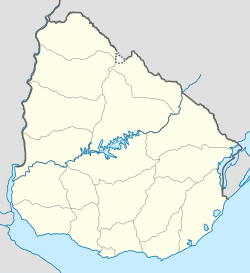Salto, Uruguay
| Salto | ||
|---|---|---|
| Department capital city | ||

Monument to José Gervasio Artigas, by Edmundo Prati, at Plaza Artigas in downtown Salto.
|
||
|
||
| Location in Uruguay | ||
| Coordinates: 31°23′0″S 57°57′0″W / 31.38333°S 57.95000°WCoordinates: 31°23′0″S 57°57′0″W / 31.38333°S 57.95000°W | ||
| Country |
|
|
| Department | Salto Department | |
| Founded | 1756 | |
| Population (2011) | ||
| • Total | 104,028 | |
| • Demonym | salteño | |
| Time zone | UTC -3 | |
| Postal code | 50000 | |
| Dial plan | +598 473 (+5 digits) | |
| Climate | Cfa | |
| Website | http://www.salto.gub.uy | |
Salto is the capital city of the Salto Department in northwestern Uruguay. As of the 2011 census it had a population of 104,028 and is the second most populated city in Uruguay.
The city is located on Route 3 about 496 kilometres (308 mi) northwest of Montevideo, and on the east bank of the Río Uruguay across from the city of Concordia in Argentina. About 12 kilometres (7.5 mi) north of the city the Salto Grande Bridge, built on top of the Salto Grande Dam, joins the two sides.
Built on hills and bluffs, the city is situated near the Rio Uruguay's 'big jump' falls, which is also the location of the Salto Grande Dam. The land is low lying alongside the river bank, with an elevation of 48 metres (157 ft) above sea level.
During the Guarani War the governor of Rio de la Plata, José de Andonaegui, and the Marquis of Valdelirios pleaded with Governor José Joaquín de Viana to move north with an army of 400 men and enforce the terms of the Treaty of Madrid. In October 1756 Viana built several barracks for his army located in the area who had to survive on hunting and fishing. The sheds he built were called San Antonio del Salto Chico. Thus, the short-lived first settlement in the present city of Salto dates from 8 November 1756, which remains as its date of foundation. Some people say it was "by chance", such as the writer Francisco Bauza in his book Dominación española en Uruguay. In 1757, Viana and the superior Governor of Buenos Aires, Pedro de Cevallos, built a strong fort called San Antonio. The fort had a chapel, which was under the patronage of San Antonio de Padua. Also in that period, Spanish troops captured the Portuguese colony at Colonia del Sacramento and used its facilities for seven years before abandoning it in 1763.
...
Wikipedia


